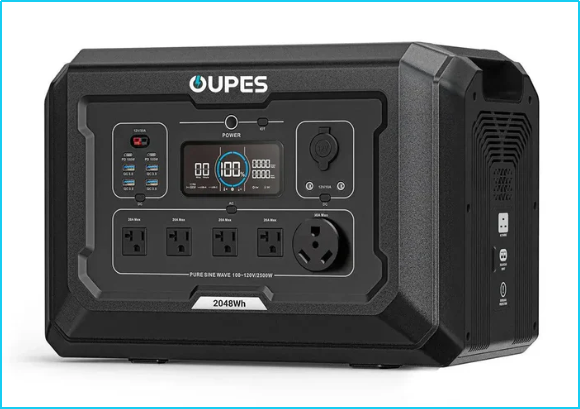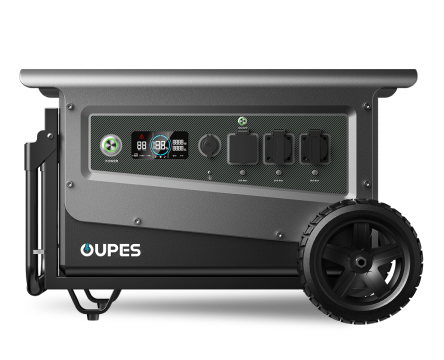
Overview
Solar backup batteries have become one of the most reliable and sustainable solutions for storing energy generated from solar panels. As natural disasters and power outages become more frequent, more homeowners, RV travelers, and off-grid enthusiasts depend on solar battery systems to maintain access to electricity. According to the International Energy Agency (IEA), global battery storage capacity has grown rapidly in the past decade, driven by increased solar adoption and improved battery technologies.
In simple terms, solar backup batteries store excess solar energy and make it available when sunlight is not present—such as during nighttime, cloudy weather, or grid outages. This article explores how these systems work, the technology behind them, and how portable power stations and solar generators support reliable backup power for homes and outdoor use.
What Are Solar Backup Batteries?
Definition
A solar backup battery is an energy storage system designed to store electricity generated by solar panels. This stored energy can then be used to power appliances, charge devices, or supply electricity during outages.
Purpose
They provide:
- Off-grid power independence
- Emergency backup power
- Energy cost savings
- Silent, eco-friendly electricity
How Solar Backup Batteries Work
Step 1: Solar Panels Capture Sunlight
Solar panels convert sunlight into direct current (DC) electricity through photovoltaic (PV) cells. The U.S. Department of Energy states that modern panels achieve conversion efficiencies between 15% and 22%.
Step 2: Electricity Passes Through a Charge Controller
The charge controller regulates voltage and current to prevent overcharging and protect the battery. MPPT (Maximum Power Point Tracking) controllers are the most efficient technology.
Step 3: Energy is Stored in the Battery
The battery stores energy as chemical potential. LiFePO4 (Lithium Iron Phosphate) batteries are the most recommended for modern solar systems because of safety, long life cycles, and temperature stability.
Step 4: The Inverter Converts DC Power to AC Power
Most home appliances and tools run on AC power. The inverter transforms the DC electricity into usable AC output.
Step 5: Power Is Supplied to Your Home or Devices
Stored energy can now be used anytime, including during outages or at night. This ensures uninterrupted power.
Key Components of a Solar Backup Battery System
1. Solar Panels
Responsible for capturing and converting solar radiation into usable electricity.
2. Charge Controller
Protects the battery from overcharging and ensures efficient charging.
3. Battery Pack
Stores the energy. Most modern systems use LiFePO4 due to high safety and long lifespan.
4. Inverter
Converts DC to AC power. Pure sine wave inverters offer the cleanest output and prevent damage to sensitive devices.
5. Monitoring System
Advanced systems offer app control, WiFi monitoring, and real-time energy statistics.
Types of Solar Backup Batteries
LiFePO4 (Lithium Iron Phosphate)
Offers high safety, long cycle life (often 3500+ cycles), and thermal stability. Ideal for home backup and portable power stations.
Lithium-Ion
High energy density but less stable and with shorter cycles compared to LiFePO4.
Lead-Acid (AGM, Gel)
Lower cost but heavy, shorter-lived, and less efficient. Typically used in older systems.
Solar Generators & Portable Power Stations
A solar generator is a portable system that combines a battery, inverter, charge controller, and various output ports into a single integrated unit. When paired with solar panels, it becomes a complete solar backup solution.
How They Relate to Backup Batteries
Solar generators function as compact, portable versions of home solar battery systems. They can power essential appliances such as refrigerators, CPAP machines, communication tools, and lights during emergencies.
Why They Are Growing in Popularity
According to recent market data from the Solar Energy Industries Association (SEIA), portable solar power systems are one of the fastest-growing segments due to increased demand for clean backup power and rising frequency of grid outages.
Comparison Table: Battery Types
| Battery Type | Pros | Cons | Typical Use Case |
|---|---|---|---|
| LiFePO4 | Long lifespan High safety Efficient charging Lightweight |
Higher initial cost | Portable power stations Home solar backup |
| Lithium-Ion | High energy density Widely available |
Less stable Shorter cycle life |
Electronics Light-duty backup |
| Lead-Acid | Low cost Easy to source |
Heavy Low efficiency Short lifespan |
Old RV systems Legacy battery banks |
Benefits of Using Solar Backup Batteries
1. Energy Independence
Solar backup batteries reduce reliance on the grid and provide continuous energy even during outages.
2. Environmentally Friendly
Solar energy produces zero emissions, helping reduce carbon footprint.
3. Silent Operation
Unlike gas generators, solar systems operate quietly with no fumes, making them ideal for indoor or RV use.
4. Cost Savings
Pairing solar batteries with rooftop panels can significantly reduce electricity bills over time.
5. Long Lifespan
LiFePO4 batteries commonly last over 3500 cycles—often 10 years or more depending on usage.
Common Applications
Home Backup Power
Solar backup batteries provide electricity for critical appliances during storms, earthquakes, or grid failures.
RV & Van Life
Solar generators offer off-grid power for refrigerators, lights, fans, laptops, and more.
Outdoor Recreation
Ideal for camping, fishing, tailgating, and remote work setups.
Emergency Preparedness
Since solar backup systems don’t rely on fuel, they are perfect for disaster kits.
How to Choose the Right Solar Backup Battery
1. Capacity (Wh)
Higher capacity allows longer runtime. For emergency use, 1000–3000Wh is ideal.
2. Power Output (W)
Determines what appliances you can run. Portable power stations with 1000–4000W output cover most home needs.
3. Battery Chemistry
LiFePO4 offers the best safety, stability, and lifespan for solar backup.
4. Solar Input Capacity
The higher the solar input, the faster your battery recharges during extended outages.
5. Portability
Consider weight, wheels, handles, and compactness based on intended use.
How OUPES Fits Into Solar Backup Power
OUPES offers portable power stations that integrate LiFePO4 batteries, high-efficiency inverters, and fast solar charging capabilities. These systems provide reliable backup power for homes, RVs, and emergency kits. While this article is educational, OUPES serves as an example of how portable solar battery technology allows users to achieve safe, renewable, and long-lasting power independence.
FAQ
1. How long can a solar backup battery power my home?
It depends on capacity and appliance usage. A 2000Wh unit can power essentials—lights, fans, laptops, and small appliances—for many hours.
2. Can solar batteries work without solar panels?
Yes. They can also charge from AC outlets or car ports. Solar panels simply provide renewable energy.
3. Are solar backup batteries safe?
LiFePO4-based systems are among the safest energy storage technologies available due to thermal stability.
4. Can I use a solar generator indoors?
Absolutely. Solar generators produce no emissions and are safe for indoor use.
5. How long do solar backup batteries last?
LiFePO4 batteries often last 10+ years with proper care, offering thousands of charge cycles.




























